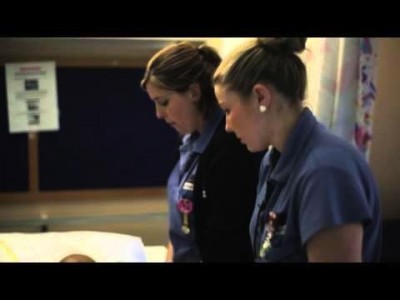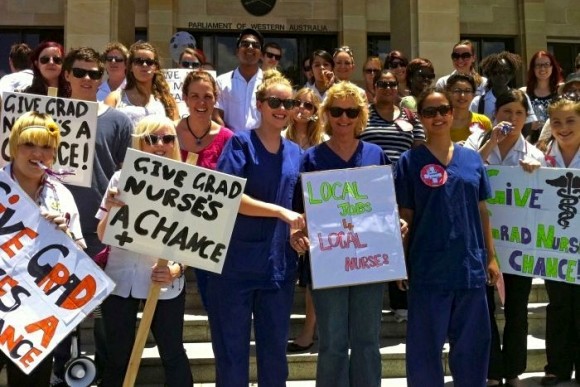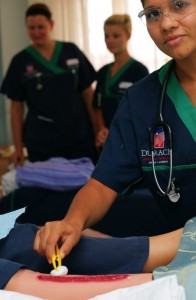Thousands of local nursing graduates are desperately unemployed despite large numbers of international nurses being recruited under the 457 Visa Programme. An independent review panel has been appointed by the Federal Government to assess current regulations regarding employers recruiting offshore skilled labour and is now due to report.
Another day. Another rejection letter.
This is a story that is becoming all too familiar amongst graduate nurses in Australia. The Australian Nursing and Midwifery Federation (ANMF), estimates that nearly 40 per cent of newly-graduated nurses will be unable to find employment this year. The consistent increase of nursing graduates since 2002 has sadly been negated by the chronic unemployment of graduate nurses.
The New South Wales Nursing and Midwifery Association (NSWNMA) has confirmed there are no regulations preventing new graduates being employed after they are registered with the Australian Health Practitioner Regulation Agency (AHPRA).
Many of the increasing number of graduate nurses who struggle to find employment in their field are rejected by employers who utilise offshore nursing labour. According to the Australian Bureau of Statistics (ABS), the proportion of international nurses increased by 10 per cent from 2001 to 2011.
The Temporary Skilled Migration Programme, also known as the 457 Programme, was designed as a safeguard in times of short term and unpredicted labour demands. It allows employers to access offshore skilled labour when an Australian worker is not available to fill a position.
In April the ANMF made a submission requesting the federally appointed review panel asses the integrity of the 457 Visa Programme. The request focuses on the lack of employment opportunities for new graduates and a review of the current regulations on employers recruiting large numbers of offshore skilled workers.
“Migration programs should not be used as a primary strategy to overcome nursing and midwifery shortages,” says the ANMF.
Annie Butler, acting federal secretary of the ANMF, recently said on ABC’s Lateline:
“It can’t be a coincidence that at the same time as thousands of new nurse graduates across the country are unable to get jobs, the same amount of people are getting jobs, coming in as temporary skilled migrants on 457 visas.”
According to Nick Blake, Senior Federal Industrial Officer for the ANMF, the 457 Programme “has now become the principal vehicle for skilled labour to come to Australia”. This demonstrates disconnect between the current policy, allowing high levels of international recruitment, and the present supply of new graduate nurses.
After legislation was enacted in 2008, workers on the 457 visa are to be paid the equivalent of an Australian worker. Bitter complaints by employers assert that this equivalency is a disincentive to use 457 labour:
“This claim is of course rubbish evidenced by the growing numbers of 457 workers,” said Mr Blake.
While the ANMF acknowledged employers require their labour needs to be met, it also emphasised the importance of looking at local employees first, and equivalent treatment of international employees in the workforce.
Although the 457 Programme is classified as a temporary long-stay visa the ANMF reports that over 70 per cent of 457 nurses become permanent residents within a year of beginning their temporary employment.
 Concern has also radiated from the Australian Council of Trade Unions (ACTU) which fears the Government’s focus on deregulation and its “earn or learn” policy may leave international workers susceptible to exploitation and push unemployed local nurses towards poverty. Deregulation could result in the disposal of current protections, such as English language requirements and the minimum salary threshold paid to 457 workers. Without these protections the already devastating unemployment of local nurses is likely to intensify.
Concern has also radiated from the Australian Council of Trade Unions (ACTU) which fears the Government’s focus on deregulation and its “earn or learn” policy may leave international workers susceptible to exploitation and push unemployed local nurses towards poverty. Deregulation could result in the disposal of current protections, such as English language requirements and the minimum salary threshold paid to 457 workers. Without these protections the already devastating unemployment of local nurses is likely to intensify.
ACTU secretary Dave Oliver has slammed the “earn or learn” policy in an interview with political editor Alison Carabine on ABC Radio. Mr Oliver attacked the policy saying it will “throw young people [those under 30 years] into poverty”, and labelling it a “push by business to reduce paying conditions of workers around the country”.
Mr Oliver rejected the additional proposal to cut penalty rates, maintaining that cuts to pay would not decrease unemployment among nurses but instead increase the gap between minimum wage earners and average wage earners which may lead to “an entrenched US-style working poor”.
The ANMF and ACTU have appealed to the Federal Government to ensure Australian workers get increased opportunities to apply for positions before employers use 457 recruitment.
The NSWNMA is a contributor to the ANMF’s submission, calling for the maintenance of labour market testing to ensure local nurses are allowed the opportunity to fill vacancies. Maintaining industrial and professional parity between local and international nurses, as well as improving post-graduation training, are the key concerns of the NSWNMA.
So why do employers recruit 457 nurses? After enquiring with the ANMF, NSWNMA, ACTU and Australian Healthcare and Hospitals Association (AHHA), is seems there is no simple answer.
In fact Michael Roff, CEO of the Australian Private Hospitals Association, recently told Lateline that it is harder to employ 457 workers with employers required to provide evidence that the position has been advertised as well as proof of the number of applicants and interviews.
One possible explanation is that the Department of Immigration and Border Protection has marketed the 457 programme as a quick and seamless option for employees and employers. As explained by the ANMF, the Department promoted the programme as a six-week processing period opposed to a permanent migration programme that can take up to 12 months.
The NSWNMA’s explanation suggests a severe lack of funding to assist employers in hiring new graduates in positions that require post-graduate experience is largely to blame for the increase in international nurses. The NSWNMA is urging both Federal and State governments to install tiered funding which they believe would allow employers to hire more new graduates.
More controversially, a Nursing Unit Manager and Recruitment Supervisor at a major Sydney hospital revealed that the vast majority of 457 workers enter the health system through the private sector, after paying hefty fees to gain the experience needed to apply for public sector positions.
“The public sector won’t employ international nurses until they have worked in an acute care setting for 6-12 months. There is no benefit for the public sector to hire international nurses, but the private sector is different; they would receive some sort of benefit for employing 457 nurses. Exactly what that is, I don’t know but you can be fairly sure it’s financial.”
According to the ANMF’s submission, 457 nurses can fulfil their training obligations by either paying a minimum 2 per cent of the total payroll expenditure to an industry training fund, or a minimum 1 per cent to the training of Australian workers or permanent residents employed by the business. This structure is ineffective, with extra resources “typically being consumed by medical staff, specialists and senior management”.
The review panel is yet to release its final report which was due on June 30.
For now, with rejection letters flowing, it is important to maximise the investment in educating professional health care workers and prevent a lost generation of Australian nurses.






